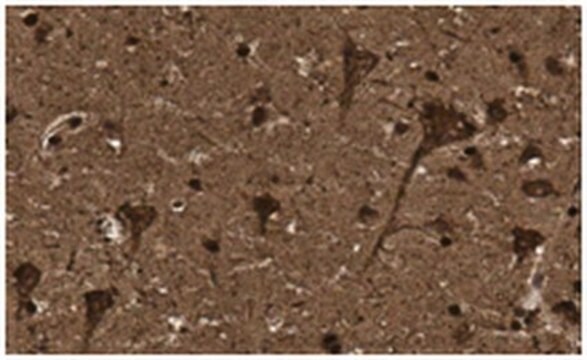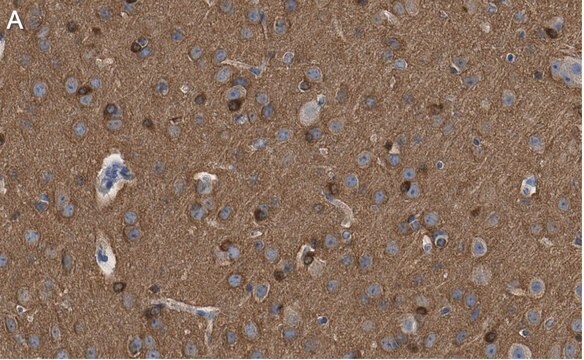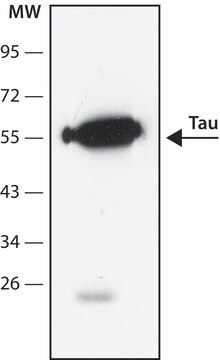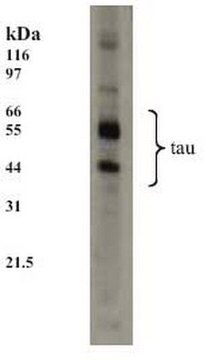ABN454-I
Anti-Tau (T22) Antibody, oligomeric
from rabbit, purified by affinity chromatography
Sinonimo/i:
Microtubule-associated protein tau oligomer, Tau oligomer, PHF-tau oligomer, Paired helical filament-tau oligomer, Neurofibrillary tangle protein oligomer
About This Item
Prodotti consigliati
Origine biologica
rabbit
Livello qualitativo
Forma dell’anticorpo
affinity isolated antibody
Tipo di anticorpo
primary antibodies
Clone
polyclonal
Purificato mediante
affinity chromatography
Reattività contro le specie
human
tecniche
dot blot: suitable
immunofluorescence: suitable
immunohistochemistry: suitable
western blot: suitable
N° accesso NCBI
N° accesso UniProt
Condizioni di spedizione
ambient
modifica post-traduzionali bersaglio
unmodified
Informazioni sul gene
human ... MAPT(4137)
Descrizione generale
Specificità
Immunogeno
Applicazioni
Neuroscience
Dot Blot Analysis: A representative lot detected human P301S tau oligomers in hippocampal dentate gyrus (DG) and medial entorhinal cortex (MEC) tissue lysates from PS19 transgenic mice. Daily N-SMase Inhibitor GW4869 i.p. injection reduced tau oligomer accumulation in DG, but not MEC (Asai, H., et al. (2015). Nat. Neurosci. 18(11):1584-1593).
Dot Blot Analysis: A representative lot detected increased tau oligomers formation in Alzheimer′s diseased (AD) as well as in aged non-AD human medial temporal gyrus tissue lysates (Blair, L.J., et al. (2013). J. Clin. Invest. 123(10):4158-4169).
Immunohistochemistry Analysis: A representative lot detected human tau oligomers formation in paraffin-embedded striatal sections of Huntington s diseased brains (Vuono, R., et al. (2015). Brain. 138(Pt 7):1907-1918).
Immunohistochemistry Analysis: A representative lot detected increased human tau P301L mutant oligomers formation in CA3 region of Tg4510 mice following FKBP51-expressing AAV viarl particles injection using 4% paraformaldehyde-fixed free-floating brain sections (Blair, L.J., et al. (2013). J. Clin. Invest. 123(10):4158-4169).
Immunofluorescence Analysis: A representative lot detected granule cell layer (GCL) neurons containing oligomers of virally expressed human P301L mutant tau 1 441 by fluorescent immunohistochemistry staining of brain sections from mice received recombinant viral injection to the medial entorhinal cortex (MEC) (Asai, H., et al. (2015). Nat. Neurosci. 18(11):1584-1593).
Immunofluorescence Analysis: A representative lot detected greatly enhanced tau oligomers co-localized with that of oxidative nucleic acid damage marker 8-OH(d)G in human AD brain, as well as heat stress- (HS-) induced Tau oligomers formation in the brain CA1 region of THY-Tau22 transgenic mice expressing human tau with G272V and P301S mutation by fluorescent immunohistochemistry staining of paraffin-embedded brain tissue sections (Violet, M., et al. (2015). Neurobiol. Dis. 82:540-551).
Western Blotting Analysis: A representative lot detected human P301S tau oligomers-containing exosomal fractions from PS19 transgenic mice. Dietary supplementation with CSF-1R Inhibitor PLX3397 reduced exosomal tau oligomer accumulation (Asai, H., et al. (2015). Nat. Neurosci. 18(11):1584-1593).
The unpurified antiserum (Cat. No. ABN454) is also available for dot blot, ELISA, immunofluorescence, immunohistochemistry, immunoprecipitation, neutralization, and Western blotting applications.
Qualità
Dot Blot Analysis: 2 µg/mL of this antibody detected 100 ng of in vitro generated recombinant human tau oligomers, but not tau monomer.
Descrizione del bersaglio
Stato fisico
Stoccaggio e stabilità
Handling Recommendations: Upon receipt and prior to removing the cap, centrifuge the vial and gently mix the solution. Aliquot into microcentrifuge tubes and store at -20°C. Avoid repeated freeze/thaw cycles, which may damage IgG and affect product performance.
Altre note
Esclusione di responsabilità
Non trovi il prodotto giusto?
Prova il nostro Motore di ricerca dei prodotti.
Raccomandato
Codice della classe di stoccaggio
12 - Non Combustible Liquids
Classe di pericolosità dell'acqua (WGK)
WGK 2
Punto d’infiammabilità (°F)
Not applicable
Punto d’infiammabilità (°C)
Not applicable
Certificati d'analisi (COA)
Cerca il Certificati d'analisi (COA) digitando il numero di lotto/batch corrispondente. I numeri di lotto o di batch sono stampati sull'etichetta dei prodotti dopo la parola ‘Lotto’ o ‘Batch’.
Possiedi già questo prodotto?
I documenti relativi ai prodotti acquistati recentemente sono disponibili nell’Archivio dei documenti.
Il team dei nostri ricercatori vanta grande esperienza in tutte le aree della ricerca quali Life Science, scienza dei materiali, sintesi chimica, cromatografia, discipline analitiche, ecc..
Contatta l'Assistenza Tecnica.








